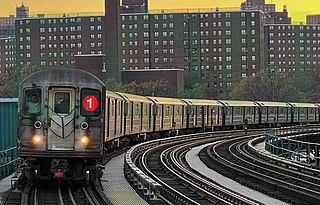
The New York City Subway is a rapid transit system in the New York City boroughs of Manhattan, Brooklyn, Queens, and the Bronx. It is owned by the government of New York City and leased to the New York City Transit Authority, an affiliate agency of the state-run Metropolitan Transportation Authority (MTA). Opened on October 27, 1904, the New York City Subway is one of the world's oldest public transit systems, one of the most-used, and the one with the most stations, with 472 stations in operation.
The Second Avenue Subway is a New York City Subway line that runs under Second Avenue on the East Side of Manhattan. The first phase of this new line, with three new stations on Manhattan's Upper East Side, opened on January 1, 2017. The full Second Avenue Line, if and when it will be funded, will be built in three more phases to eventually connect Harlem–125th Street in Harlem to Hanover Square in Lower Manhattan. The proposed full line would be 8.5 miles (13.7 km) and 16 stations long, serve a projected 560,000 daily riders, and cost more than $17 billion.

The 125th Street station is an express station with four tracks and two island platforms. It is the northernmost Manhattan station on the IRT Lexington Avenue Line of the New York City Subway. Located at Lexington Avenue and East 125th Street in East Harlem, it is served by the 4 and 6 trains at all times, the 5 train at all times except late nights, and the <6> train during weekdays in peak direction. This station was constructed as part of the Dual Contracts by the Interborough Rapid Transit Company and opened in 1918.

The Pelham Bay Park station is the northern terminal station of the IRT Pelham Line of the New York City Subway. Located across from Pelham Bay Park, at the intersection of the Bruckner Expressway and Westchester Avenue in the Pelham Bay neighborhood of the Bronx, it is served by the 6 train at all times, except weekdays in the peak direction, when the <6> serves it.

The New Lots Avenue station is the eastern terminal of the IRT New Lots Line of the New York City Subway. Located in East New York, Brooklyn, it is the terminal for the 3 train at all times except late nights, when the 4 train takes over service. During rush hours, occasional 2, 4, and 5 trains also stop here.

The Third Avenue–138th Street station is an express station on the IRT Pelham Line of the New York City Subway located at the intersection of Third Avenue and East 138th Street in the Bronx. It is served by the 6 train at all times and the <6> train during weekdays in the peak direction.

The Wakefield–241st Street station is a terminal station on the IRT White Plains Road Line of the New York City Subway, located at the intersection of 241st Street and White Plains Road in the Wakefield neighborhood of the Bronx. It is served by the 2 train at all times. This station is geographically the northernmost station in the entire New York City Subway system.

The 57th Street–Seventh Avenue station is an express station on the BMT Broadway Line of the New York City Subway. Located in Midtown Manhattan at the intersection of 57th Street and Seventh Avenue, it is served by the N and Q trains at all times, the R train at all times except late nights, and the W train on weekdays. It is directly adjacent to Carnegie Hall.

The Second Avenue station is a station on the IND Sixth Avenue Line of the New York City Subway, located at the intersection of Second Avenue and Houston Street on the border between the East Village and the Lower East Side, in Manhattan. It is served by the F train at all times and the <F> train during rush hours in the peak direction.
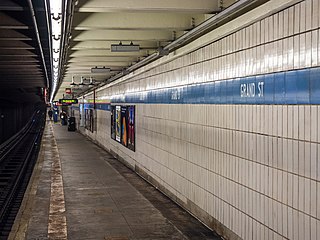
The Grand Street station is an express station on the IND Sixth Avenue Line of the New York City Subway. Located at the intersection of Grand Street and Chrystie Street at the border of Chinatown and the Lower East Side, it is served by the D train at all times and the B train on weekdays.
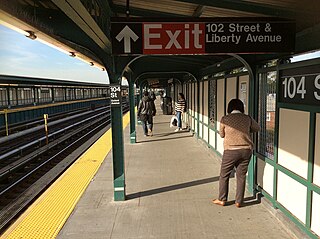
The 104th Street station is a station on the IND Fulton Street Line of the New York City Subway, located on Liberty Avenue at 104th Street in Ozone Park, Queens. The station is served by the Lefferts Boulevard branch of the A train at all times.

The Tremont Avenue station is an express station on the IND Concourse Line of the New York City Subway. Located at the intersection of East Tremont Avenue and Grand Concourse, it is served by the D train at all times and B train during rush hours only. It has three tracks and two island platforms.

The Lexington Avenue–63rd Street station is a New York City Subway station in Lenox Hill, Manhattan, shared by the IND and BMT 63rd Street Lines. Located at the intersection of Lexington Avenue and 63rd Street, it is served by the Q train at all times; an F shuttle train at all times except late nights; limited rush hour N trains in the southbound direction only; and one A.M. rush hour R train in the northbound direction only.
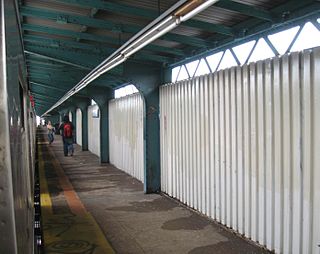
The 104th Street station is a skip-stop station on the BMT Jamaica Line of the New York City Subway, located on Jamaica Avenue between 102nd and 104th Streets in Richmond Hill, Queens. It is served by the Z train during rush hours in the peak direction, and the J at all other times.

The 96th Street station is a station on the IND Second Avenue Line of the New York City Subway. Located at the intersection of Second Avenue and 96th Street on the border of the Upper East Side/Yorkville and East Harlem neighborhoods in Manhattan, it is the northern terminus for the Q train at all times. It is also served by limited southbound rush hour N trains and one northbound morning rush hour R train. The station is the terminus for the first phase of the Second Avenue Line.
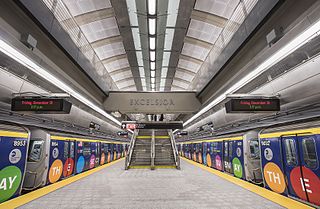
The 86th Street station is a station on the first phase of the Second Avenue Line of the New York City Subway. Located at the intersection of Second Avenue and 86th Street, in the Yorkville section of the Upper East Side in Manhattan, it opened on January 1, 2017. The station is served by the Q train at all times, limited southbound rush hour N trains, and one northbound A.M. rush hour R train. There are two tracks and an island platform.

The 72nd Street station is a station on the first phase of the Second Avenue Line of the New York City Subway. Located at the intersection of Second Avenue and 72nd Street, in the Lenox Hill section of the Upper East Side in Manhattan, it opened on January 1, 2017. The station is served by the Q train at all times, limited southbound rush hour N trains, and one northbound A.M. rush hour R train.

116th Street is a planned station along the IND Second Avenue Line of the New York City Subway. It would be located at the intersection of Second Avenue and 116th Street in East Harlem, Manhattan. Proposed since 1968, the station is expected to be built as part of Phase 2 of the Second Avenue Subway. When opened, it will initially be served by the Q train, with the T train providing service when Phase 3 of the line is built.
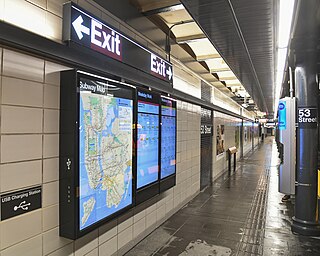
Since the late 20th century, the Metropolitan Transportation Authority has started several projects to maintain and improve the New York City Subway. Some of these projects, such as subway line automation, proposed platform screen doors, the FASTRACK maintenance program, and infrastructural improvements proposed in 2015–2019 Capital Program, contribute toward improving the system's efficiency. Others, such as train-arrival "countdown clocks", "Help Point" station intercoms, "On the Go! Travel Station" passenger kiosks, wireless and cellular network connections in stations, MetroCard fare payment alternatives, and digital ads, are meant to benefit individual passengers. Yet others, including the various methods of subway construction, do not directly impact the passenger interface, but are used to make subway operations efficient.

The Second Avenue Subway, a New York City Subway line that runs under Second Avenue on the East Side of Manhattan, has been proposed since 1920; the first phase of the line did not open until 2017. Up until the 1960s, many distinct plans for the Second Avenue subway line were never carried out, though small segments were built in the 1970s. The complex reasons for these delays are why the line is sometimes called "the line that time forgot".























